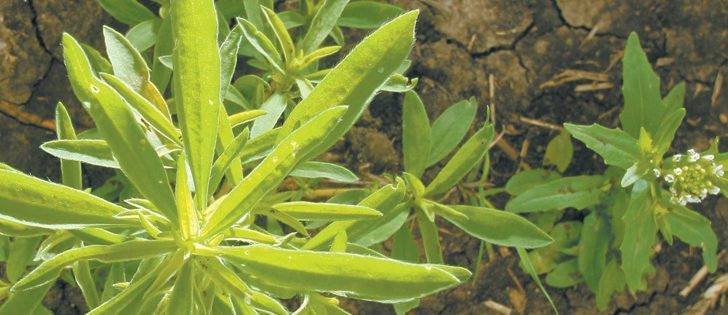
Know Your Enemy: Kochia Biology and Control
By Shannon Chant, PAg., Crops Extension Specialist, Swift Current
Kochia plants have been easy to find in Saskatchewan over the last few years. Unfortunately, kochia’s biology and herbicide-resistant populations make it a difficult weed to control. Like any other weed, kochia plants can compete with crops for water, nutrients and sunlight.
The best start to a weed control plan is to know the enemy! Let’s get started.

Kochia is an annual weed that has a type of photosynthesis known as C4. C4 plants, such as corn and kochia, can produce sugars for a longer period of time during hot or dry conditions than C3 plants like wheat and soybean. Under ideal growing conditions, C3 plants will outgrow C4 plants. Germination of kochia can occur under a range of conditions:
- Temperature: Seeds can germinate in soil temperatures as low as 2 C and as high as 40 C.
- Timing: In Western Canada, rapid germination occurs from mid-April to early-May, but can extend into June.
- Salinity: Seeds can germinate in saline soils, but germination may be slower.
- Seed depth: The optimal depth for emergence is from the soil surface to two centimetres.
- pH: Seeds are tolerant of extremes in pH.
- Longevity: Seeds are viable in the soil seedbank for one to two years.
Considerations for control with herbicides:
- Timing: Herbicides in the 2020 Guide to Crop Protection registered to control or suppress kochia have a range of application timings, from before kochia emergence to plants that are six inches high. Always check the product label to ensure you are applying the herbicide at the recommended crop and weed stages. Post-emergent herbicide application timing may miss the seeds that germinate well into the growing season.
- Herbicide resistance: Populations in Saskatchewan are resistant to Group 2 herbicides. Testing kochia samples that were collected in the 2017 Alberta weed survey found that 40 per cent of the samples tested positive for glyphosate resistance, eight per cent tested positive for dicamba resistance and 10 per cent were found to have three-way resistance (glyphosate, Group 2 products and dicamba). The dicamba-resistant samples will be tested for resistance to fluroxypyr, as well. It is very likely that kochia populations similar to the ones found in Alberta exist in west-central and southwest Saskatchewan.
- Plant characteristics: Herbicides can have trouble getting into the kochia plant because the leaves are covered in a soft, downy hair and have crystalline wax on the surface of the leaf. If a herbicide droplet gets stuck above the surface of the leaf, it won’t be absorbed into the plant. Surfactants can help overcome this for some products and should always be included if recommended. High temperatures can reduce the absorption or translocation of certain products. Some herbicides have a recommended minimum or maximum temperature for application. Spraying using these guidelines will help get the best results from the application.
Mechanical options can be used to help control kochia populations:
- Tilling kochia plants that have survived herbicide application and form a pattern from where a tumbleweed from a resistant plant blew across the field and dropped seed can be beneficial. Kochia is associated with no-till production systems; seedlings germinating from the seed bank can be four times higher in a no-till system than a system with tillage. This does not mean that farmers should change to a production system with more tillage over the long term. Patterns of kochia plants through a fallow field should be worked down as soon as possible, but the entire field does not need to be cultivated. Tillage to bury kochia seeds below four centimetres after a year with a very high kochia population may reduce seedling emergence in the next year. In a greenhouse study, there was no emergence from seeds that were buried deeper than four centimetres.
- Mowing in ditches and other areas that do not have crops to control plants.
- Cutting a crop for green feed before kochia sets seed can be effective.
- Pulling isolated, individual plants before they have a chance to tumble is also a very good strategy to avoid resistance.
Kochia plants can produce 10,000 to 25,000 seeds per plant, which are spread by tumbleweeds rolling across fields. These seeds can easily establish in the spring. Any practice that can remove plants before seed sets is an important part of control.
For the latest information and for more updates on everything Kindersley ‘Like’ the Kindersley Social Facebook page below…








































